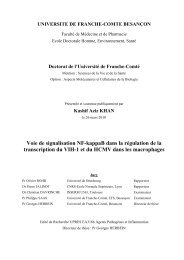these - Université de Franche-Comté
these - Université de Franche-Comté
these - Université de Franche-Comté
Create successful ePaper yourself
Turn your PDF publications into a flip-book with our unique Google optimized e-Paper software.
DPPC<br />
phosphatidylglycérol<br />
phosphatidylsérine et<br />
phosphatidylinositol<br />
sphingomyéline<br />
Figure 13 : Composition phospholipidiques du surfactant chez l’homme<br />
Tableau III : composition phospholipidique du surfactant<br />
DPPC 75%<br />
phosphatidylglycérol 10%<br />
phosphatidylsérine<br />
et<br />
phosphatidylinositol<br />
5%<br />
sphingomyéline 4%<br />
La phosphatidylcholine (PC), dont la moitié est saturée, est le composé le plus abondant dans<br />
le surfactant. La PC saturée consiste surtout en DPPC responsable <strong>de</strong> l’activité <strong>de</strong> surface du<br />
surfactant. Ensuite, le phosphatidylglycérol (PG) est le <strong>de</strong>uxième plus abondant <strong>de</strong>s PPL. (8)<br />
Région<br />
aliphatique<br />
hydrophobe<br />
DPPC (figure 14)<br />
Région polarisée hydrophile<br />
Figure 14 : Structure moléculaire et spatiale du DPPC<br />
Source : www.<strong>de</strong>a-cardiopneumo.org doc_telechargementbiblio_rbourbon.pdf<br />
Le DPPC possè<strong>de</strong> un pôle hydrophobe constitué d’aci<strong>de</strong> gras apolaire qui sont les résidus<br />
palmitate, et qui sont très huileux et donc insolubles dans l’eau. La partie polaire, relativement<br />
36









